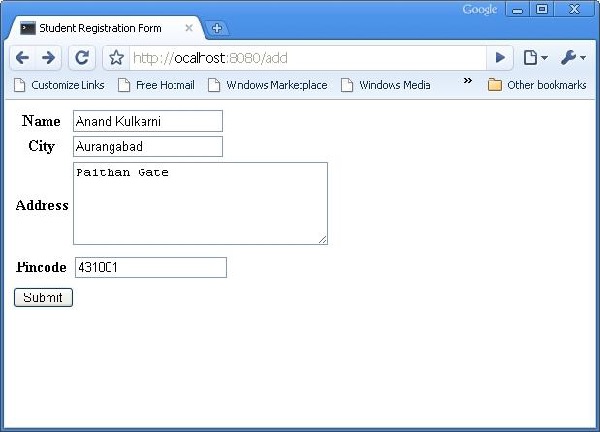
- TurboGears 教程
- TurboGears - 主页
- TurboGears - 概述
- TurboGears - 环境
- TurboGears - 第一个程序
- TurboGears - 依赖关系
- TurboGears - 服务模板
- TurboGears - HTTP 方法
- Genshi模板语言
- TurboGears - 包括
- TurboGears - JSON 渲染
- TurboGears - URL 层次结构
- TurboGears - Toscawidgets 表格
- TurboGears - 验证
- TurboGears - 闪讯
- TurboGears - Cookie 和会话
- TurboGears - 缓存
- TurboGears - Sqlalchemy
- TurboGears - 创建模型
- TurboGears - 原油操作
- TurboGears - 数据网格
- TurboGears - 分页
- TurboGears - 管理员访问
- 授权与认证
- TurboGears - 使用 MongoDB
- TurboGears - 脚手架
- TurboGears - 挂钩
- TurboGears - 编写扩展
- TurboGears - 可插拔应用
- TurboGears - 安静的应用程序
- TurboGears - 部署
- TurboGears 有用资源
- TurboGears - 快速指南
- TurboGears - 有用的资源
- TurboGears - 讨论
TurboGears – CRUD 操作
以下会话方法执行 CRUD 操作 -
DBSession.add(model object) - 将记录插入到映射表中。
DBSession.delete(model object) - 从表中删除记录。
DBSession.query(model).all() - 从表中检索所有记录(对应于 SELECT 查询)。
您可以使用过滤器属性对检索到的记录集应用过滤器。例如,为了检索学生表中 city = 'Hyderabad' 的记录,请使用以下语句 -
DBSession.query(model.student).filter_by(city = ’Hyderabad’).all()
现在我们将了解如何通过控制器 URL 与模型进行交互。
首先让我们设计一个ToscaWidgets表单来输入学生的数据
你好\你好\controllers.studentform.py
import tw2.core as twc
import tw2.forms as twf
class StudentForm(twf.Form):
class child(twf.TableLayout):
name = twf.TextField(size = 20)
city = twf.TextField()
address = twf.TextArea("",rows = 5, cols = 30)
pincode = twf.NumberField()
action = '/save_record'
submit = twf.SubmitButton(value = 'Submit')
在 RootController(Hello 应用程序的 root.py)中,添加以下函数映射“/add”URL -
from hello.controllers.studentform import StudentForm
class RootController(BaseController):
@expose('hello.templates.studentform')
def add(self, *args, **kw):
return dict(page='studentform', form = StudentForm)
将以下 HTML 代码保存为模板文件夹中的Studentform.html -
<!DOCTYPE html>
<html xmlns = "http://www.w3.org/1999/xhtml"
xmlns:py = "http://genshi.edgewall.org/"
lang = "en">
<head>
<title>Student Registration Form</title>
</head>
<body>
<div id = "getting_started">
${form.display(value = dict(title = 'Enter data'))}
</div>
</body>
</html>
启动服务器后在浏览器中输入http://localhost:8080/add 。以下学生信息表将在浏览器中打开 -

上面的表单被设计为提交到“/save_record” URL。因此,需要在root.py中添加save_record()函数来公开它。来自学生表单的数据由该函数作为dict()对象接收。它用于在学生模型下的学生表中添加新记录。
@expose()
#@validate(form = AdmissionForm, error_handler = index1)
def save_record(self, **kw):
newstudent = student(name = kw['name'],city = kw['city'],
address = kw['address'], pincode = kw['pincode'])
DBSession.add(newstudent)
flash(message = "new entry added successfully")
redirect("/listrec")
请注意,添加成功后,浏览器将重定向到'/listrec' URL。该 URL 由listrec() 函数公开。该函数选择student表中的所有记录,并将它们以dict对象的形式发送到studentlist.html模板。listrec ()函数如下 -
@expose ("hello.templates.studentlist")
def listrec(self):
entries = DBSession.query(student).all()
return dict(entries = entries)
Studentlist.html 模板使用 py:for 指令迭代条目字典对象。Studentlist.html 模板如下 -
<html xmlns = "http://www.w3.org/1999/xhtml"
xmlns:py = "http://genshi.edgewall.org/">
<head>
<link rel = "stylesheet" type = "text/css" media = "screen"
href = "${tg.url('/css/style.css')}" />
<title>Welcome to TurboGears</title>
</head>
<body>
<h1>Welcome to TurboGears</h1>
<py:with vars = "flash = tg.flash_obj.render('flash', use_js = False)">
<div py:if = "flash" py:replace = "Markup(flash)" />
</py:with>
<h2>Current Entries</h2>
<table border = '1'>
<thead>
<tr>
<th>Name</th>
<th>City</th>
<th>Address</th>
<th>Pincode</th>
</tr>
</thead>
<tbody>
<py:for each = "entry in entries">
<tr>
<td>${entry.name}</td>
<td>${entry.city}</td>
<td>${entry.address}</td>
<td>${entry.pincode}</td>
</tr>
</py:for>
</tbody>
</table>
</body>
</html>
现在重新访问http://localhost:8080/add并在表单中输入数据。单击提交按钮,浏览器将转到studentlist.html。它还会闪烁一条“新记录添加成功”消息。
